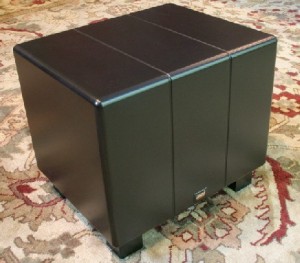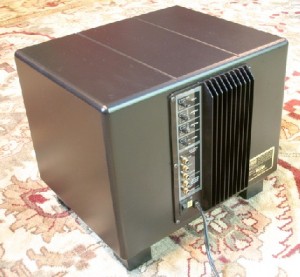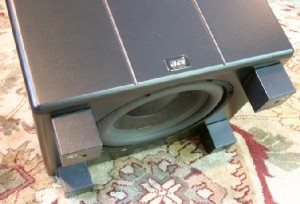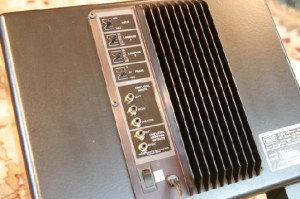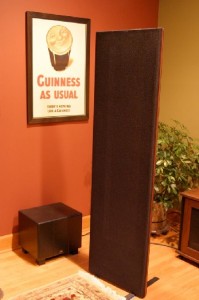Specifications
- Driver: 10” down firing, proprietary ultra long throw
- Bass Loading: sealed with a system Q < .6
- Frequency Response: 20-250Hz ±3db
- Low Pass Crossover: dual adjustable filters from 35-
- 250Hz, each 12db/oct. for 24db/oct. total
- High Pass Crossover: fixed 100Hz 12db/oct., left and right line level RCA outputs
- Volume: continuously variable input level
- Phase Control: continuously variable 0-180º
- Line Level Inputs: right and left RCA inputs (also used for high level inputs using speaker level converters)
- Theater Direct Input: RCA input bypassing volume control
- Special Circuitry: protection and woofer behavior control
- Supplied Accessories: Subwoofer Setup CD, speaker level converters (RCA to wire connectors with built-in resistance)
- Dimensions: 13.5” H x 16.75” W x 12.5” D (original model), 15.75″ x 13.75” x 13.75 (new Force XL) Price: $750 (satin black), $850 (inlaid cherry), $950 (piano black)
I have a love/hate relationship with subwoofers. I love the sense of dynamics, fullness and space that they add to the music by extending my system’s response down into the bottom octave. But I sometimes hate the hoops you have to jump through to get them set up just right, representing yet another component I will inevitably obsess over whether or not I’ve fully optimized. Unfortunately, you can’t have one without the other. Although the set up of almost any subwoofer can be tedious and requires painstaking trial and error (newer self-calibrating subs notwithstanding), the sonic benefits delivered by a high-quality subwoofer such as the ACI Force XL are well worth that extra effort.
ACI Force XL Subwoofer review
Not Much Bigger Than a Bread Box
In comparison to many other subs, the ACI Force is relatively small and does a great job of visually disappearing into its surroundings. My pair is the original design in the standard “architectural black” finish without the optional solid wood end panels. The Force recently received an upgraded look with slightly taller proportions, an integral bottom plate instead of feet, and what appears to be a much nicer finish judging by the website photos. Renamed the Force XL, it now matches the look of ACI’s Sapphire XL monitors reviewed in the February issue. All other features, specifications and performance attributes remain the same.
The down-firing woofer is a 10” ultra long throw driver powered by a custom-built, alldiscreet, high-current amplifier delivering 250 watts at less than .5% distortion. It can be hooked up to your system via line-level stereo preamp outputs, high-level speaker outputs using the provided level converters, or the LFE output from a surround processor/ receiver using the Theater Direct Input. Extensive information on all of the various setup configurations can be found at the ACI website.
ACI also offers the option of using in-line, passive, high-pass filters (available in 65 and 85 Hz settings) to roll off the bass sent to your power amp, thereby relieving it of all that heavy low-end lifting. I’ve been down that road in the past with the Vandersteen 2wq subwoofer, and while it blended very well with my Magnepan 1.6QR speakers, I was never completely satisfied with how the filter in the signal path affected the top-end. Moreover, my current system does not allow for this option as I am using a PS Audio GCC-100 integrated amp which does not have a preamp/amp loop out. However, it does provide an auxiliary preamp output, which is what I use to send the left and right signals to the stereo pair of Force XL subs.
Beware the “Wack-A-Mole” Syndrome
While the Force XL is visually unobtrusive, it is of course a subwoofer’s sonic disappearing act that is much more important. In addition to the volume control, there are dual 12db/octave low-pass crossover filters that are continuously and individually adjustable from 35 Hz to 250 Hz. Where they overlap, they form a steeper 24db/octave curve for greater flexibility in matching the roll-off slope to the bottom end response of your speakers. There is also a continuously variable phase control (0-180º) which I found to be essential in getting the smoothest response as even small 25º changes could reinforce or cut different frequencies.
Combined with room placement options, these adjustments allow you to extensively tweak the Force’s response so that it completely disappears into the soundstage (like any good speaker should) and prevent it from extending too far into the upper registers and thereby mucking up the midrange. The only downside is that these variables beg to be changed and manipulated in the hope that you can eek that last bit of performance out of your system. I’m also using stereo Force subs which add an additional level of complexity. To help in this process, ACI provides a Subwoofer Setup CD with sine and warble tones as well as a downloadable spreadsheet available at their website so that you can measure and graph the results using an inexpensive Radio Shack db meter.
One word of warning: I quickly found myself spiraling down into a sort of “Wack-A-Mole” situation. I would make an adjustment to the crossovers, phase or subwoofer positions, take measurements and graph the results, only to find that while one area of the response improved I had made matters worse in another. Much of this stemmed from my initial attempts to use the subs as a kind of equalizer to smooth out peaks and dips in the upper bass frequencies inherent to my room and listening position. After many hours over many days of adjusting, measuring, graphing and listening, I finally realized that I needed to simply use the subs for their intended purpose of extending the lowend response of my Maggies. From there it was much easier to dial them into my system.
Shiver Me Timbers
The Magnepan 1.6QR speakers provide decent in-room, low-end response all on their own, with a slight dip around 60 Hz and then rolling off steeply just below 35 Hz. Their dipole midrange and bass characteristics are extraordinary and I was worried that a subwoofer would not be able to do them justice. But the Force XL proved an ideal match with one positioned next to each speaker along the side walls. Within the aesthetic confines of my room (I cannot position the subs between my speakers), this gave me the deepest bass with the smoothest response.
Bass from the Force XL is taut and deep, consistent with what is typically described as a “fast” subwoofer in that it does not exhibit any excess overhang or bloat. It starts and stops on a dime based on whatever material you toss its way. Tuck Andress’ incredible guitar work on his solo album Reckless Precision is delivered with greater harmonic richness thanks to the Force’s ability to add the deep resonance and low-end weight that forms the warm foundation of his 1953 Gibson guitar, all while keeping up with his lightening fast and complex fingering. This album is a great example of minimalist recording, going direct to a digital recorder with no overdubbing, and the intimate performance takes on much more presence with the Force XL subs.
Another example, the initial strikes on the drums throughout the Empire Brass Quintet’s “Hopper Dance” (Passages 138 B.C. – A.D.) are presented by the Force with excellent clarity and speed while the subsequent rumbling expands into the ambience of the venue. The same is true of the thunderclap at the beginning and end of this track. Lesser subs, or even good subs with the volume/crossover turned up too high, can sound excessively boomy and ponderous, revealing that there is subwoofer in the room. It is not so much that you can specifically localize the subwoofer in these circumstances, but that the bass does not sound like it is part of the performance and emanating from the same soundstage. Typically (though not an absolute), I have found this to be more prevalent with vented subs as opposed to a low-Q sealed design like the Force.
The Force XL is also able to generate incredibly thunderous and deep bass that fills the room when called into action by the source material, which was quite surprising for such a diminutive subwoofer. Certain recordings, especially many electronica or techno titles, require the reproduction of what often seems like overpowering bass. While not a staple of audiophile-approved reference recordings, Laurie Anderson’s “My Compensation” from Life on a String, has a massive deep bass drum effect that fully energizes the room when properly reproduced. Without the Force XL subs it was only hinted at in the background, causing the ambience of the entire song to collapse. This track also made it apparent the Force can definitely get things rattling and highlighted a couple of loose window panes in my 1920’s era home. In fact, using the ACI Subwoofer Setup CD, I could feel 15 Hz tones generated by the Force subs even though these frequencies cannot be heard.
One of the more surprising improvements that a high-quality subwoofer can provide is an increased sense of space and ambience. The Magnepans are already great at portraying a large and visceral soundstage, but it seems even deeper and wider when the Force XL subs are turned on. Moving to another electronicaoriented artist, the auditory landscape of Brian Eno’s Nerve Net becomes all the more enveloping as low-level bass cues, like reverberations and the decay of drums, come through with greater clarity and definition to better define this artificial environment. Similarly, on live recordings such as the Tuck Andress and Empire String Quartet titles mentioned earlier, the Force greatly enhances the feeling of being transported into the actual performance space. Echoes and the sounds rolling off into the distance carry greater weight and create a much more palpable presence of the venue.
Two Subs or Not Two Subs
Of course, the question arises whether or not two subs are really necessary. The simple answer is “NO.” Depending upon the size of your listening room and placement options, a single Force will perform quite nicely. However, a stereo pair does provide some advantages if you are willing to accept the added cost and complexity. Most notable is the ability to create a smoother response curve by having bass frequencies emanate from two different locations. Practicality and money aside, rumor on the online forums is that a quartet of Force subs, one in each corner of a room, is the ultimate solution.
Going back to “My Compensation” by Laurie Anderson, I found that the deep bass drum effect was still impressively powerful but did not energize the room quite as fully and evenly with a single Force XL. It tended to roll through the listening room, rather than surround and envelope you as was the case with two subs. The sense of spaciousness also seemed somewhat less pronounced on this as well as the other recordings, albeit the actual differences were quite subtle. Though I did prefer the smoothness of a stereo pair in my listening room, I would not hesitate to use a single Force XL as it goes impressively deep and with astounding impact for a 10” driver in such a small sealed cabinet.
Home Theater Bonus
Because the Force XL is capable of such remarkable window-rattling output, it is also well-suited for home theater duties and a Theater Direct Input is provided for connection to a surround processor or receiver’s LFE subwoofer output. This bypasses the volume control so that you can instead adjust the amount of LFE with your processor, which is much more convenient if you make frequent changes depending upon whether you are playing multi-channel music versus movie SFX. However, the Theater Direct Input still goes through the dual crossovers. If using only this input and managing bass with a surround processor/ receiver, it is simply a matter of setting the crossovers at their maximum 250 Hz settings to avoid any overlap.
You can also use the Theater Direct Input along with the regular L/R inputs. I have the Force subs connected to both my dedicated 2 channel system as well as my multichannel surround system. Although I keep the subwoofer crossovers optimized for 2-chanel music, which therefore also rolls-off the LFE signal, the amount of “.1” channel bass output and impact remains impressive when playing movies or surround sound recordings (if you can set the bass management low enough on your surround processor you should be able to avoid any “hole” in the LFE output in this situation). I’m sure you can get more profound and teeth-jarring performance for the most extreme low-frequency sound effects from a larger sub like ACI’s Titan and Maestro. But for me, the Force XL delivers all of the explosive concussions and dinosaur stomps that I (or my old house) can handle.
Wrap Up
If you want a subwoofer that you can just plunk down, plug in and be done, then the numerous adjustments on the Force XL may well drive you crazy during setup. For that matter, I’m not sure any sub would fit this bill and deliver all the sonic goods that the Force provides (aside from some of the more expensive selfcalibrating units that come with a microphone). While it would be nice to have some form of on-board equalization for additional contouring of the bass, it is far more effective to use something like the R-DES Digital EQ ($295 with the purchase of any ACI subwoofer) which combines a highlycustomizable crossover and equalizer into a small computer-programmable unit inserted before the subwoofer’s input.
More than just filling in the bottom octave, the Force’s dual crossovers and variable phase allow it to blend seamlessly with my Magnepans so that it never intrudes on their fantastic mid-range and expands the already impressive soundstage. I expect such will be the case with most any speaker. While the Magnepans are thoroughly enjoyable speakers in their own right, I cannot now imagine them without the ACI Force XL.
Review Equipment
- Magnepan 1.6QR speakers
- PS Audio GCC-100 integrated amp
- Cary 306/200 CDP/DAC
- Squeezebox 3 digital music streamer
external link: ACI Force XL website
 from affordableaudio, By Craig Johnson
from affordableaudio, By Craig Johnson

